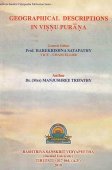Vamshanucarita, Vaṃśānucarita, Vamsha-anucarita: 10 definitions
Introduction:
Vamshanucarita means something in Hinduism, Sanskrit, Marathi. If you want to know the exact meaning, history, etymology or English translation of this term then check out the descriptions on this page. Add your comment or reference to a book if you want to contribute to this summary article.
The Sanskrit term Vaṃśānucarita can be transliterated into English as Vamsanucarita or Vamshanucarita, using the IAST transliteration scheme (?).
Alternative spellings of this word include Vamshanucharita.
In Hinduism
Purana and Itihasa (epic history)
Source: Cologne Digital Sanskrit Dictionaries: The Purana IndexVaṃśānucarita (वंशानुचरित).—One of the five characteristics of a purāṇa;1 also Vaṃśyānucaritam.2
- 1) Brahmāṇḍa-purāṇa I. 1. 38; Viṣṇu-purāṇa VI. 8. 2 and 13.
- 2) Matsya-purāṇa 2. 22; 53. 65; Vāyu-purāṇa 4. 11.
Vaṃśānucarita (वंशानुचरित) refers to “accounts of royals dynasties” and represents one of the various aspects of the Pañcalakṣaṇa definition of Purāṇas, according to Amarakoṣa: the famous Sanskrit lexicon of the 5th Century A.D.—Accordingly, the Purāṇas are supposed to contain theories about [viz., vaṃśānucarita (accounts of royals dynasties)].—While giving the definition of Vaṃśānucarita the Bhāgavatapurāṇa says “It is the history of the kings and their most distinguished descendants”.
The Saurapurāṇa 30.27-73 and chapter 31 descibes the vaṃśānucarita in an abridged form. It is stated that Aditi got from Kaśyapa, Bhāskara, the Sun-god. The Sun-god had four wives—Saṃjñā, Rājñī, Prabhā and Chāyā. Saṃjñā gave birth to Manu from the Sun-god in whose race were born the kings.

The Purana (पुराण, purāṇas) refers to Sanskrit literature preserving ancient India’s vast cultural history, including historical legends, religious ceremonies, various arts and sciences. The eighteen mahapuranas total over 400,000 shlokas (metrical couplets) and date to at least several centuries BCE.
Languages of India and abroad
Marathi-English dictionary
Source: DDSA: The Molesworth Marathi and English Dictionaryvaṃśānucarita (वंशानुचरित).—n S A traditional practice or fashion. 2 A pedigree or genealogical list.
Marathi is an Indo-European language having over 70 million native speakers people in (predominantly) Maharashtra India. Marathi, like many other Indo-Aryan languages, evolved from early forms of Prakrit, which itself is a subset of Sanskrit, one of the most ancient languages of the world.
Sanskrit dictionary
Source: DDSA: The practical Sanskrit-English dictionaryVaṃśānucarita (वंशानुचरित).—the history of a dynasty or family.
Derivable forms: vaṃśānucaritam (वंशानुचरितम्).
Vaṃśānucarita is a Sanskrit compound consisting of the terms vaṃśa and anucarita (अनुचरित).
Source: Cologne Digital Sanskrit Dictionaries: Shabda-Sagara Sanskrit-English DictionaryVaṃśānucarita (वंशानुचरित).—n.
(-taṃ) A pedigree, a genealogical list, or history. E. vaṃśa a family, anu implying succession, and carita proceeded.
Source: Cologne Digital Sanskrit Dictionaries: Monier-Williams Sanskrit-English DictionaryVaṃśānucarita (वंशानुचरित):—[from vaṃśa] n. the history of a family or dynasty, a genealogical list (one of five distinguishing marks of a Purāṇa), [Bhāgavata-purāṇa; Indian Wisdom, by Sir M. Monier-Williams 511.]
Source: Cologne Digital Sanskrit Dictionaries: Yates Sanskrit-English DictionaryVaṃśānucarita (वंशानुचरित):—[vaṃśā+nucarita] (taṃ) 1. n. A pedigree; genealogical list, or history.
[Sanskrit to German]
Sanskrit, also spelled संस्कृतम् (saṃskṛtam), is an ancient language of India commonly seen as the grandmother of the Indo-European language family (even English!). Closely allied with Prakrit and Pali, Sanskrit is more exhaustive in both grammar and terms and has the most extensive collection of literature in the world, greatly surpassing its sister-languages Greek and Latin.
Kannada-English dictionary
Source: Alar: Kannada-English corpusVaṃśānucarita (ವಂಶಾನುಚರಿತ):—[noun] the history of a family or dynasty (in a literary work).
Kannada is a Dravidian language (as opposed to the Indo-European language family) mainly spoken in the southwestern region of India.
See also (Relevant definitions)
Partial matches: Vamsha, Anucarita.
Ends with: Gangavamshanucarita.
Full-text (+147): Pancalakshana, Nabhas, Dynasty, Lineage, Creation, Recreation, Bhaskara, Purana, Five characteristics, Rajni, Savarni, Prabha, Nakula, Yamuna, Prabhata, Revanta, Tapati, Vishti, Vaivasvatamanu, Shani.
Relevant text
Search found 15 books and stories containing Vamshanucarita, Vaṃśānucarita, Vamsha-anucarita, Vamsanucarita, Vaṃśa-anucarita, Vamsa-anucarita, Vamśanucarita; (plurals include: Vamshanucaritas, Vaṃśānucaritas, anucaritas, Vamsanucaritas, Vamśanucaritas). You can also click to the full overview containing English textual excerpts. Below are direct links for the most relevant articles:
Historical Elements in the Matsya Purana (by Chaitali Kadia)
Characteristics of Purāṇa < [Chapter 1 - An Introduction of the Purāṇas]
Human History in the Matsya Purāṇa (Introduction) < [Chapter 6 - Human history in the Matsya-Purāṇa]
The Matsya Purana (critical study) (by Kushal Kalita)
Part 5 - Pañca-lakṣaṇa (the five characteristics) and the Matsyapurāṇa < [Chapter 1 - Introduction]
Historical Aspects of the Purāṇas (Introduction) < [Chapter 3 - Historical aspects in the Matsyapurāṇa]
The Markandeya Purana (Study) (by Chandamita Bhattacharya)
Vedic influence on the Sun-worship in the Puranas (by Goswami Mitali)
Part 1 - Purāṇic Literature < [Chapter 3 - General Characteristics of the Purāṇic Religion and its Link with the Vedic Tradition]
Puranic encyclopaedia (by Vettam Mani)
The Bhagavata Purana (by G. V. Tagare)
Chapter 7 - The Branches of the Atharva Veda: Characteristics of the Purāṇas < [Book 12 - Twelfth Skandha]
Part 1 - Bhāgavata Purāṇa with Ten Characteristic Topics < [Introduction]
Chapter 1 - Dialogue between Sūta and Śaunaka in the Naimiśa forest < [Book 1 - First Skandha]
Related products
